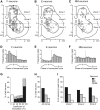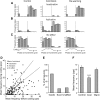Effects of reversible spinalization on individual spinal neurons
- PMID: 24285903
- PMCID: PMC3841459
- DOI: 10.1523/JNEUROSCI.2394-13.2013
Effects of reversible spinalization on individual spinal neurons
Abstract
Postural limb reflexes (PLRs) represent a substantial component of the postural system responsible for stabilization of dorsal-side-up trunk orientation in quadrupeds. Spinalization causes spinal shock, that is a dramatic reduction of extensor tone and spinal reflexes, including PLRs. The goal of our study was to determine changes in activity of spinal interneurons, in particular those mediating PLRs, that is caused by spinalization. For this purpose, in decerebrate rabbits, activity of individual interneurons from L5 was recorded during stimulation causing PLRs under two conditions: (1) when neurons received supraspinal influences and (2) when these influences were temporarily abolished by a cold block of spike propagation in spinal pathways at T12 ("reversible spinalization"; RS). The effect of RS, that is a dramatic reduction of PLRs, was similar to the effect of surgical spinalization. In the examined population of interneurons (n = 199), activity of 84% of them correlated with PLRs, suggesting that they contribute to PLR generation. RS affected differently individual neurons: the mean frequency decreased in 67% of neurons, increased in 15%, and did not change in 18%. Neurons with different RS effects were differently distributed across the spinal cord: 80% of inactivated neurons were located in the intermediate area and ventral horn, whereas 50% of nonaffected neurons were located in the dorsal horn. We found a group of neurons that were coactivated with extensors during PLRs before RS and exhibited a dramatic (>80%) decrease in their activity during RS. We suggest that these neurons are responsible for reduction of extensor tone and postural reflexes during spinal shock.
Keywords: cold block; postural reflexes; rabbit; spinal cord injury; spinal neurons.
Figures









Similar articles
-
Putative spinal interneurons mediating postural limb reflexes provide a basis for postural control in different planes.Eur J Neurosci. 2015 Jan;41(2):168-81. doi: 10.1111/ejn.12780. Epub 2014 Nov 5. Eur J Neurosci. 2015. PMID: 25370349 Free PMC article.
-
Effects of acute spinalization on neurons of postural networks.Sci Rep. 2016 Jun 15;6:27372. doi: 10.1038/srep27372. Sci Rep. 2016. PMID: 27302149 Free PMC article.
-
Effect of acute lateral hemisection of the spinal cord on spinal neurons of postural networks.Neuroscience. 2016 Dec 17;339:235-253. doi: 10.1016/j.neuroscience.2016.09.043. Epub 2016 Oct 1. Neuroscience. 2016. PMID: 27702647 Free PMC article.
-
Vasopressin in the locus coeruleus and dorsal pontine tegmentum affects posture and vestibulospinal reflexes.Prog Brain Res. 1998;119:537-54. doi: 10.1016/s0079-6123(08)61592-7. Prog Brain Res. 1998. PMID: 10074811 Review.
-
Spinal and supraspinal postural networks.Brain Res Rev. 2008 Jan;57(1):212-21. doi: 10.1016/j.brainresrev.2007.06.017. Epub 2007 Jul 27. Brain Res Rev. 2008. PMID: 17822773 Free PMC article. Review.
Cited by
-
Changes in Activity of Spinal Postural Networks at Different Time Points After Spinalization.Front Cell Neurosci. 2019 Aug 21;13:387. doi: 10.3389/fncel.2019.00387. eCollection 2019. Front Cell Neurosci. 2019. PMID: 31496938 Free PMC article.
-
Animal Models of Spinal Cord Injury.Biomedicines. 2025 Jun 10;13(6):1427. doi: 10.3390/biomedicines13061427. Biomedicines. 2025. PMID: 40564146 Free PMC article. Review.
-
Developing an optimized strategy with transcranial direct current stimulation to enhance the endogenous pain control system in fibromyalgia.Expert Rev Med Devices. 2018 Dec;15(12):863-873. doi: 10.1080/17434440.2018.1551129. Epub 2018 Dec 3. Expert Rev Med Devices. 2018. PMID: 30501532 Free PMC article. Review.
-
Putative spinal interneurons mediating postural limb reflexes provide a basis for postural control in different planes.Eur J Neurosci. 2015 Jan;41(2):168-81. doi: 10.1111/ejn.12780. Epub 2014 Nov 5. Eur J Neurosci. 2015. PMID: 25370349 Free PMC article.
-
Simultaneous bidirectional hindlimb locomotion in decerebrate cats.Sci Rep. 2021 Feb 5;11(1):3252. doi: 10.1038/s41598-021-82722-2. Sci Rep. 2021. PMID: 33547397 Free PMC article.
References
-
- Ashby P, Verrier M. Neurophysiological changes following spinal cord lesions in man. Can J Neurol Sci. 1975;2:91–100. - PubMed
-
- Baldissera F, Hultborn H, Illert M. Integration in spinal neuronal systems. In: Brooks VB, editor. Handbook of physiology, Sec 1, The nervous system, Vol 2, Motor control. Bethesda, MD: American Physiological Society; 1981. pp. 509–595.
-
- Barnes CD, Joynt RJ, Schottelius BA. Motoneuron resting potentials in spinal shock. Am J Physiol. 1962;203:1113–1116. - PubMed
Publication types
MeSH terms
Grants and funding
LinkOut - more resources
Full Text Sources
Other Literature Sources
Medical
